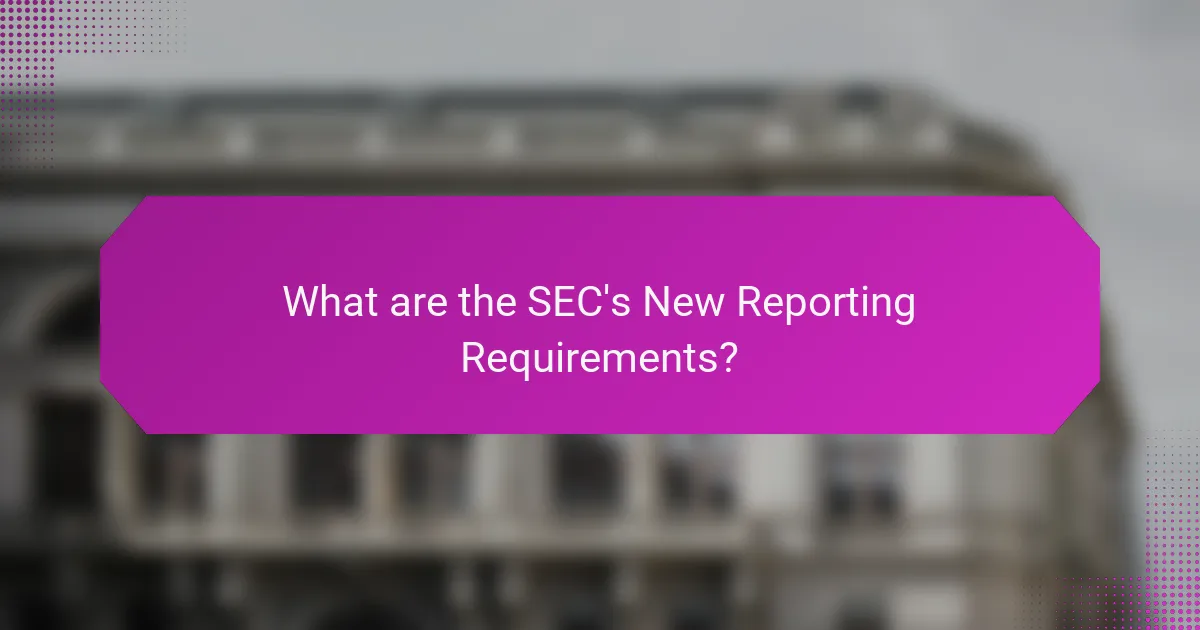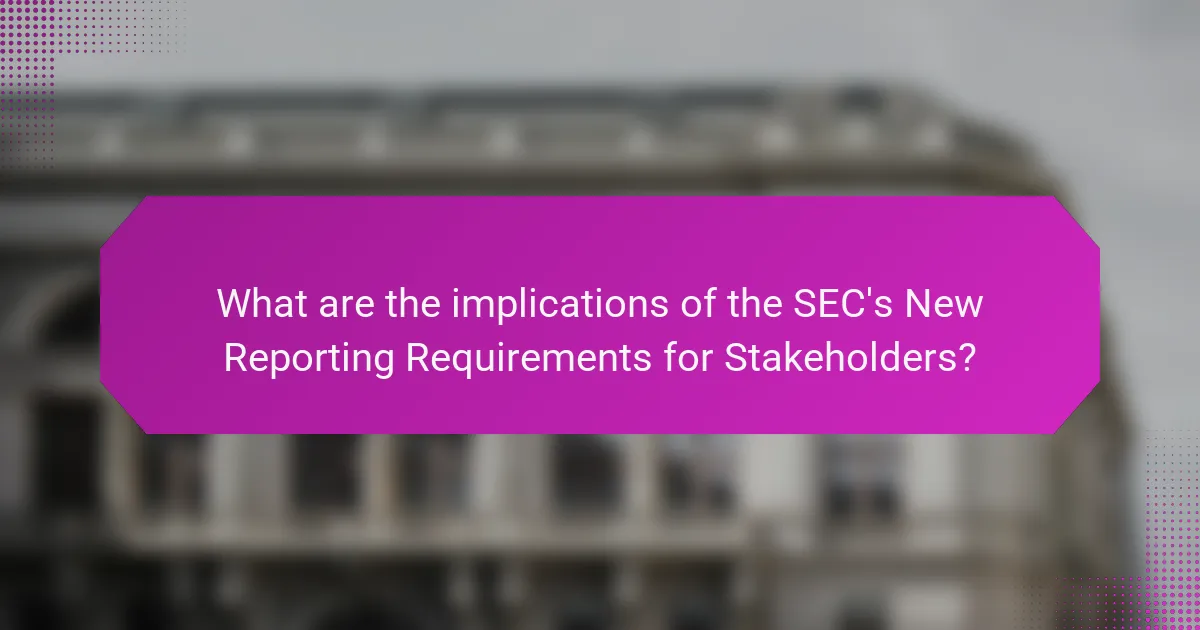
What are the SEC’s New Reporting Requirements?
The SEC’s new reporting requirements mandate increased transparency in securities lending transactions. These requirements aim to enhance the data available to regulators and investors. They include the need for reporting of securities lending activity on a daily basis. Additionally, firms must disclose details such as the identity of borrowers and the terms of the loans. This shift is designed to mitigate risks associated with securities lending. It also helps in monitoring market stability. The new rules were proposed to address concerns raised during periods of market volatility. Compliance with these requirements is expected to begin in 2024.
How do these requirements impact the securities lending market?
The SEC’s new reporting requirements significantly impact the securities lending market. These requirements increase transparency and accountability among market participants. They mandate detailed disclosures about securities lending transactions. This change may lead to enhanced regulatory scrutiny of lending practices. Consequently, lenders may face higher compliance costs. Increased compliance costs could reduce the profitability of securities lending. Additionally, transparency may deter some participants from entering the market. Overall, these requirements reshape the operational landscape of securities lending.
What specific changes have been introduced in the reporting process?
The SEC has introduced several specific changes in the reporting process for securities lending. These changes include enhanced transparency requirements for lenders and borrowers. Entities must now report securities lending transactions more frequently. The SEC mandates reporting on a T+1 basis, which increases the speed of data submission. Additionally, firms are required to provide detailed information on collateral types and values. The new rules also demand disclosure of counterparty identities in certain situations. These changes aim to improve market oversight and reduce systemic risk. The SEC’s updates reflect a shift towards greater accountability in the securities lending market.
How do these changes affect transparency in securities lending?
The changes in reporting requirements enhance transparency in securities lending. Increased disclosure mandates require lenders to provide detailed information about transactions. This includes data on loan terms, counterparties, and collateral. As a result, market participants gain better visibility into lending practices. Enhanced transparency helps regulators monitor market risks more effectively. It also fosters trust among investors by reducing information asymmetry. Overall, these changes create a more informed and accountable securities lending environment.
Why were these new requirements implemented?
The new requirements were implemented to enhance transparency in the securities lending market. These changes aim to provide regulators with better oversight of lending activities. Increased reporting is intended to mitigate risks associated with market volatility. The SEC seeks to ensure that investors have access to relevant information. This initiative responds to past incidents that highlighted the need for improved regulatory measures. Enhanced data collection will help in monitoring systemic risks. Overall, the requirements are designed to promote fair practices and protect investors.
What issues were the SEC aiming to address with these changes?
The SEC aimed to address transparency and risk management issues in securities lending with these changes. Increased reporting requirements were implemented to enhance market oversight. This was in response to concerns about systemic risks and lack of information regarding securities lending transactions. By improving data collection, the SEC seeks to mitigate potential market disruptions. The changes also aim to protect investors by ensuring they have access to relevant information. Enhanced disclosure requirements are expected to foster greater accountability among market participants. Overall, the SEC’s actions are designed to promote a more stable and informed securities lending market.
How do these requirements align with broader regulatory goals?
The SEC’s new reporting requirements align with broader regulatory goals by enhancing transparency and accountability in the securities lending market. These requirements aim to provide regulators with better visibility into lending practices. Increased transparency helps mitigate systemic risks associated with securities lending. Furthermore, it supports investor protection by ensuring that market participants comply with regulatory standards. The SEC seeks to promote fair and efficient markets, which these requirements facilitate. By standardizing reporting, the SEC can more effectively monitor market activities. This aligns with its mission to protect investors and maintain fair market integrity. Overall, the requirements contribute to a more robust regulatory framework in the financial sector.

How do the SEC’s New Reporting Requirements Affect Securities Lending Practices?
The SEC’s new reporting requirements increase transparency in securities lending practices. These regulations mandate more detailed disclosures about securities lending transactions. Firms must report information such as the identity of borrowers and the terms of loans. This change aims to mitigate risks associated with securities lending. Enhanced reporting helps regulators monitor market activities more effectively. Increased transparency can also lead to better risk management practices among lenders. As a result, these requirements may impact the cost and availability of securities for lending. Overall, the SEC’s new rules are designed to promote market integrity and investor protection.
What challenges do securities lenders face under the new requirements?
Securities lenders face several challenges under the new SEC reporting requirements. Increased compliance costs are a significant hurdle. Lenders must invest in technology and personnel to meet the new standards. Additionally, the complexity of the reporting process can lead to errors and delays.
The requirement for more detailed disclosures increases the risk of non-compliance. This can result in penalties or reputational damage. Furthermore, lenders may experience reduced liquidity due to stricter regulations. This can impact their ability to manage collateral effectively.
Overall, the new requirements create a more demanding operational environment for securities lenders.
How can securities lenders adapt to these new reporting obligations?
Securities lenders can adapt to new reporting obligations by implementing advanced compliance technology. This technology can automate data collection and reporting processes. It reduces manual errors and ensures timely submissions. Additionally, securities lenders should invest in employee training on new regulations. This ensures that staff understands the requirements and can respond effectively. Regular audits of reporting practices can also help identify areas for improvement. Staying updated on regulatory changes is crucial for ongoing compliance. Engaging with industry groups can provide insights and best practices. These strategies collectively enhance compliance and operational efficiency.
What are the potential costs associated with compliance?
Potential costs associated with compliance include direct financial expenditures and resource allocation. Organizations may incur costs related to hiring compliance staff or consultants. Training existing employees on new regulations can also add to expenses. Additionally, implementing new technology systems for reporting can be costly. There may be ongoing maintenance costs for these systems as well. Non-compliance penalties can lead to significant financial repercussions. According to a report by the SEC, firms face an average of $1.5 million in compliance costs annually. These costs can vary widely depending on the size and complexity of the organization.
How might the new requirements influence market behavior?
The new reporting requirements from the SEC may lead to increased transparency in securities lending. This transparency can influence market behavior by allowing investors to better assess risks associated with lending activities. Enhanced reporting may also deter risky lending practices. As a result, lenders might adjust their strategies to comply with the new regulations. Increased compliance costs could affect the pricing of securities lending transactions. Historical data shows that regulatory changes often result in shifts in market dynamics. For instance, after the implementation of similar regulations in other sectors, market participants adapted their behaviors to mitigate risks. Thus, the new requirements are likely to reshape the landscape of securities lending.
What changes in lending strategies can be expected?
Changes in lending strategies will likely include increased transparency and compliance with regulatory requirements. Lenders may adopt more stringent risk assessment protocols. This shift aims to align with the SEC’s new reporting mandates. Additionally, there could be a move towards more data-driven decision-making. Lenders may leverage technology to enhance reporting accuracy. This evolution may also lead to a reduction in the overall volume of securities lent. Historical trends indicate that regulatory changes often prompt shifts in market behavior. For example, after the implementation of Dodd-Frank, lending practices evolved significantly to meet new standards.
How will these requirements affect the relationship between lenders and borrowers?
The new SEC reporting requirements will create a more transparent relationship between lenders and borrowers. Lenders will have access to detailed borrower information. This will facilitate better risk assessment for lenders. Borrowers may face stricter scrutiny due to enhanced data sharing. Increased transparency can lead to more informed lending decisions. It may also foster trust in the lending process. However, borrowers could experience higher costs due to compliance requirements. Overall, the relationship will shift towards greater accountability and oversight.

What are the implications of the SEC’s New Reporting Requirements for Stakeholders?
The SEC’s new reporting requirements significantly impact stakeholders by increasing transparency and accountability. These requirements mandate more detailed disclosures related to securities lending activities. Stakeholders, including investors and financial institutions, will need to adapt their reporting processes. Enhanced data on short selling and lending transactions will provide stakeholders with better insights. This could lead to improved risk assessment and decision-making. Additionally, compliance costs may rise as firms adjust to meet the new standards. Overall, the implications foster a more informed market environment.
How do these requirements impact institutional investors?
The SEC’s new reporting requirements significantly impact institutional investors. These regulations increase transparency and accountability in securities lending transactions. Institutional investors must now provide detailed disclosures about their lending activities. This may lead to increased operational costs due to compliance efforts. Additionally, the requirements could affect liquidity in the securities lending market. Investors may become more cautious in their lending practices. This cautious approach can result in reduced availability of securities for borrowing. Ultimately, these changes may alter the risk-return profile for institutional investors engaged in securities lending.
What adjustments should institutional investors make in response?
Institutional investors should enhance their compliance frameworks in response to the SEC’s new reporting requirements. They need to invest in technology that streamlines data collection and reporting processes. This will ensure accuracy and timeliness in submissions. Additionally, they should train staff on the new regulations to avoid penalties. Regular audits of reporting practices can help maintain compliance. Institutional investors may also need to reassess their securities lending strategies. Understanding the impact of these requirements on liquidity and risk management is crucial. Adapting to these changes will help mitigate potential disruptions in their operations.
How will transparency affect investor confidence?
Transparency will positively affect investor confidence. Increased transparency allows investors to make informed decisions. It reduces uncertainty regarding financial health and operational practices. When companies disclose accurate information, trust is built. Research shows that firms with higher transparency experience greater investor interest. A study by the CFA Institute found that transparency leads to lower cost of capital. This is because investors perceive lower risk in transparent firms. Thus, enhanced transparency through SEC reporting requirements can significantly boost investor confidence in securities lending.
What best practices should securities lenders adopt to comply?
Securities lenders should implement robust compliance frameworks to adhere to SEC reporting requirements. This includes maintaining accurate records of all securities lending transactions. Lenders must ensure timely reporting of loan terms, including collateral details and transaction dates. Regular audits of lending practices can help identify compliance gaps. Training staff on new regulations is essential for effective implementation. Additionally, leveraging technology for automated reporting can enhance accuracy and efficiency. Adopting these practices minimizes the risk of regulatory penalties and fosters transparency in securities lending operations.
How can technology assist in meeting reporting requirements?
Technology can assist in meeting reporting requirements by automating data collection and analysis. Automated systems can streamline the gathering of relevant data from multiple sources. This reduces human error and increases the accuracy of reported information. For example, software can integrate with existing databases to compile necessary data efficiently. Additionally, technology enables real-time reporting, allowing organizations to submit reports promptly. Cloud-based solutions facilitate easy access to data and reporting tools from anywhere. These systems often include built-in compliance checks to ensure adherence to regulations. According to a report by the SEC, technology adoption in reporting has led to a 30% reduction in compliance costs for firms.
What resources are available for securities lenders to navigate these changes?
Securities lenders can utilize various resources to navigate changes due to the SEC’s new reporting requirements. Industry associations provide guidance and updates on regulatory changes. For example, the Securities Industry and Financial Markets Association (SIFMA) offers educational materials and webinars. Legal firms specializing in securities law publish insights and analyses on compliance. Technology solutions enable lenders to automate reporting processes. Consulting firms also offer tailored advice for adapting to new regulations. Additionally, peer networks allow lenders to share best practices and insights. These resources collectively support securities lenders in understanding and adapting to the evolving regulatory landscape.
The main entity of this article is the SEC’s new reporting requirements for securities lending. These requirements mandate increased transparency and detailed disclosures in securities lending transactions, including borrower identities and loan terms, with compliance expected to begin in 2024. The article outlines how these changes will impact the securities lending market, including potential compliance costs for lenders, adjustments in lending strategies, and the implications for institutional investors. Additionally, it discusses how technology can aid in meeting these reporting obligations and the resources available to help securities lenders navigate the new regulations. Overall, the SEC’s initiatives aim to enhance market oversight and investor protection by fostering a more informed and accountable securities lending environment.
